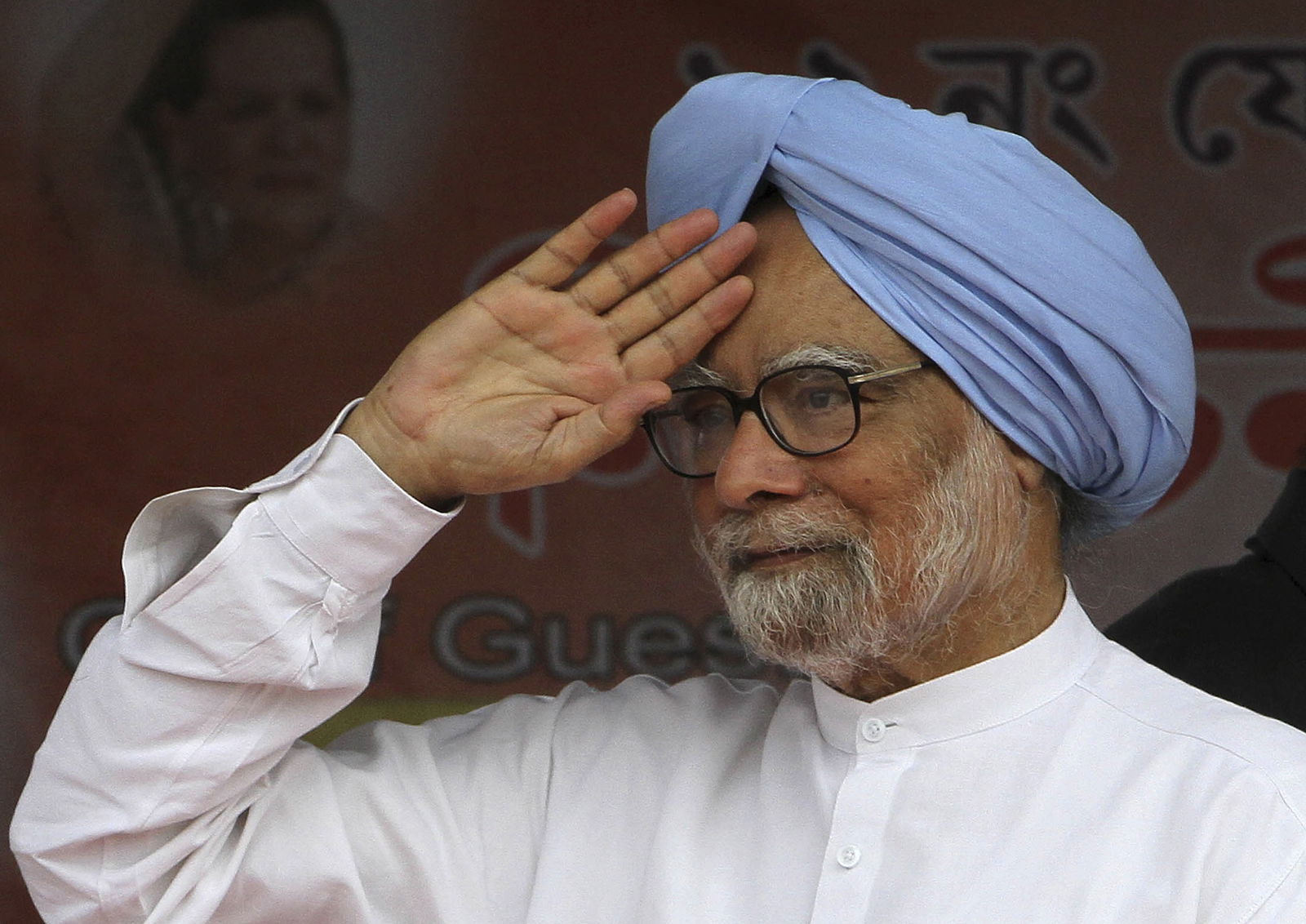Around the World briefs

By Associated Press
India’s former prime minister Manmohan Singh, architect of economic reforms, dies aged 92
NEW DELHI | India’s former Prime Minister Manmohan Singh, widely regarded as the architect of India’s economic reform program and a landmark nuclear deal with the United States, has died. He was 92.
Singh was admitted to New Delhi’s All India Institute of Medical Sciences late Thursday after his health deteriorated due to a “sudden loss of consciousness at home,” the hospital said in a statement.
“Resuscitative measures were started immediately at home. He was brought to the Medical Emergency” at 8:06 p,m., the hospital said, but “despite all efforts, he could not be revived and was declared dead at 9:51 PM.”
Singh was being treated for “age-related medical conditions,” the statement said.
A mild-mannered technocrat, Singh became one of India’s longest-serving prime ministers for 10 years and earned a reputation as a man of great personal integrity. He was chosen to fill the role in 2004 by Sonia Gandhi, the widow of assassinated Prime Minister Rajiv Gandhi.
But his sterling image was tainted by allegations of corruption against his ministers.
Singh was elected to a second term as prime minister from 2009-2014 that was clouded by financial scandals and corruption charges over the organization of the 2010 Commonwealth Games. This led to the Congress Party’s crushing defeat in the 2014 national election by the Hindu nationalist Bharatiya Janata Party under the leadership of Narendra Modi.
Singh adopted a low profile after relinquishing the post of prime minister.
Prime Minister Modi, who succeeded Singh in 2014, called him one of India’s “most distinguished leaders” who rose from humble origins and left “a strong imprint on our economic policy over the years.”
“As our Prime Minister, he made extensive efforts to improve people’s lives,” Modi said in a post on social platform X. He called Singh’s interventions in Parliament as a lawmaker “insightful” and said “his wisdom and humility were always visible.”
Pope brings Holy Year and prayers
for better future to Rome prison,
a ‘cathedral of pain and hope’
ROME | Pope Francis inaugurated his Holy Year at Rome’s main prison on Thursday, bringing a message of hope to inmates and involving them in the Catholic Church’s once every quarter-century celebration that is expected to bring about 32 million pilgrims to Rome.
Francis stood up from his wheelchair, knocked on the door to the chapel at Rebibbia prison and walked across the threshold, reenacting the gesture he performed at the Holy Door of St. Peter’s Basilica two nights earlier on Christmas Eve.
The opening of the Holy Door at the basilica officially kicked off the Jubilee year, a church tradition dating to 1300 that nowadays occurs every 25 years and involves the faithful coming to Rome on pilgrimages.
“The first Holy Door I opened at Christmas in St. Peter’s. I wanted the second one to be here, in a prison,” Francis told the Rebibbia inmates before he entered. “I wanted each of us here, inside and out, to have the possibility of throwing open the door of our hearts and understanding that hope doesn’t disappoint.”
Francis dedicated the 2025 Jubilee to hope and made clear that prisoners would be an important part of it: The final grand event of the Jubilee is a special Mass for inmates at St. Peter’s on Dec. 14, 2025. Francis has long made prison ministry an important part of his priestly vocation and has made several visits to Rebibbia since becoming pope in 2013 while also including prison visits in many of his foreign trips.
His message is always one of hope, believing that people who are serving prison sentences need something to look forward to more than most. That is especially true in Italy, where prison overcrowding and inmate suicides are at record highs, according to the Antigone Association, which tracks prison conditions.
According to Antigone’s 2024 report, 88 prisoners killed themselves in Italian lockups this year — more than any other year — and Italy’s inmate population was 132% over the system’s capacity.
In a statement Thursday, Antigone called on Italian authorities to hear Francis’ appeal to give prisoners hope. It called for structural reforms that put into practice the constitutional principles of “a punishment that is dignified, humane and looks to the social reintegration of those who are in prison.”
In his homily, Francis suggested the prisoners think of hope as an anchor that is fixed on the ground and that they try to hold tight to the rope that is attached to it, even if it sometimes hurts their hands.
“Hold onto the rope of hope, hold onto the anchor,” Francis said. “Never let it go.”
Speaking to reporters outside, Francis recalled that whenever he speaks to prisoners, the first thing he always asks himself is “why them and not me.”
“Because we all can fall, the important thing is to not lose hope, to hold onto that anchor of hope,” he said.
Back at the Vatican for his noon blessing, Francis called prison “a cathedral of pain and hope” as he repeated his message. He also doubled down on his 2025 wish for peace in the world and for wealthy countries to reduce or eliminate the debt owed by poorer countries.
“One of the things that characterizes Jubilees is the remission of debts,” Francis said, calling the debts owed by many poor countries simply “unsustainable.”
Francis’ outing to Rebibbia on a frigid morning was his final big event of the week after he celebrated Christmas Eve Mass on Tuesday evening at St. Peter’s Basilica and delivered his Christmas Day blessing from the loggia overlooking the square.
The 88-year-old pope, who often suffers from respiratory infections in winter, has a few days to rest before gearing up for the New Year’s Eve vigil and Mass the following day.
With the St. Peter’s Holy Door now open to the public, a steady stream of pilgrims was filing into the basilica, a pace that is expected to continue through next year until the door closes on Jan. 6, 2026.
Francis’ 2025 involves a dizzying calendar of Jubilee events that will sorely test his stamina, with special Jubilee Masses for all the main groups of pilgrims who are being celebrated during the year: Adolescents, migrants, teachers and law enforcement, among others.
So far, he has only one foreign trip under study: A May visit to Turkey to commemorate the 1,700th anniversary of the Council of Nicaea, Christianity’s first ecumenical council.
Prayers and tears mark 20 years
since the Indian Ocean tsunami
that killed some 230,000 people
BANDA ACEH, Indonesia | People gathered in prayer and visited mass graves in Indonesia’s Aceh province on Thursday to mark 20 years since the massive Indian Ocean tsunami hit the region in one of modern history’s worst natural disasters.
Many wept as they placed flowers at a mass grave in Ulee Lheue village, where more than 14,000 unidentified tsunami victims are buried. It is one of several mass graves in Banda Aceh, the capital of Indonesia’s northernmost province, which was one of the areas worst hit by a magnitude 9.1 earthquake and the massive tsunami it triggered.
“We miss them and we still don’t know where they are. All we know is that every year we visit the mass grave in Ulee Lhue and Siron,” said Muhamad Amirudin, who lost two of his children 20 years ago and has never found their bodies.
“This life is only temporary, so we do our best to be useful to others,” Amirudin, visiting the grave with his wife, said.
The powerful earthquake off the coast of the Indonesian island of Sumatra on Dec. 26, 2004, triggered a tsunami that killed around 230,000 people across a dozen countries, reaching as far as East Africa. Some 1.7 million people were displaced, mostly in the four worst-affected countries: Indonesia, Sri Lanka, India and Thailand.
More than 170,000 people died in Indonesia alone.
Even though 20 years have passed, survivors in Indonesia are still grieving the loved ones they lost to the giant wave that flattened buildings all the way to the provincial capital of Banda Aceh.
Hundreds of people gathered to pray at the Baiturrahman Mosque in downtown Banda Aceh. Sirens sounded across the city for three minutes to mark the time of the earthquake.
Infrastructure in Aceh has been rebuilt and is now more resilient than before the tsunami struck. Early warning systems have been installed in coastal areas to alert residents of incoming tsunamis, providing crucial time to seek safety.
The rebuilding efforts were made possible by the support of international donors and organizations, which contributed significant funds to help the region recover. Schools, hospitals, and essential infrastructure destroyed by the disaster have been reconstructed.
In Thailand, people gathered at a memorial ceremony in Ban Nam Khem, a small fishing village in Phang Nga province that bore the brunt of the devastating wave in the country.
The tsunami claimed the lives of over 8,000 people in Thailand, including many who remain missing, leaving a deep scar in the nation’s history. Nearly 400 bodies remain unclaimed.
Mourners shed tears and comforted each other as they laid flowers at the village’s tsunami memorial. Around 300 people joined a modest ceremony with Muslim, Christian and Buddhist prayers.
Urai Sirisuk said she avoids the seaside memorial park the rest of the year because the loss of her 4-year-old daughter still cuts deep every time she’s reminded of it.
“I have this feeling that the sea has taken my child. I’m very angry with it. I can’t even put my foot in the water,” she said.
But, she said, “I still hear her voice in my ears, that she’s calling for me. I can’t abandon her. So I have to be here, for my child.”
In India, hundreds gathered at Marina beach in the southern city of Chennai in Tamil Nadu state. They poured milk into the sea to propitiate gods and offered flowers and prayers for the dead as drums beat in the background.
According to official data, 10,749 people were killed in India, including nearly 7,000 people in Tamil Nadu alone.
“It has been 20 years since the tsunami,” said 69-year-old Sadayammal, who uses one name. “We are here to pay respects to the people who lost their lives.”
In Sri Lanka, survivors and relatives of tsunami victims gathered at the coastal village of Pereliya and laid flowers at a memorial that commemorates nearly 2,000 passengers who died when their train, the Queen of the Sea, was hit by the wave. Only a few dozen people are believed to have survived.
Anura Ranjith joined the mourners to pay respects to his younger sister, Anula Ranjani, and her 9-year-old daughter who were passengers on the train. Ranjith never heard from them after that day.
“I looked for them everywhere for years and still, no information about them. Their loss is a great sorrow and pain for me. I am still grieving,” he said.
Overall, more than 35,000 people died in Sri Lanka in the tsunami. People across the country observed two minutes of silence on Thursday in memory of those who lost their lives.
Heat wave leads to warnings
of potentially devastating
wildfires in southern Australia
NEWCASTLE, Australia | Communities and firefighters across Australia’s second-most populous state were preparing Thursday for potentially devastating wild fires as a heat wave fanned by erratic winds presented the worst fire conditions in several years.
With temperatures in Victoria state reaching 99 degrees Fahrenheit and with wind changes expected throughout the day, fire chiefs have issued stark warnings to rural communities to delay travel or leave their homes and seek safety at shelters.
Several fires are currently burning out of control across the state and Victoria deputy premier Ben Carroll said the possibility for further fires in the coming days was likely.
“Dangerous fire conditions are forming today and will go right through to Saturday,” he said at a press conference in Melbourne. “New fires can start anywhere and become dangerous very quickly.
The largest uncontained fire is located in the Grampians National Park and has burnt through 55,000 hectares so far, but no homes have reported to have been lost.
However, Emergency Management Commissioner Rick Nugent said there were many residential properties on the fringes of the fire that could come under threat.
“I wouldn’t be surprised at some point if we do have residential losses,” Nugent said. “Firefighters, I can say, are doing everything possible to protect life and protect property.”
An emergency warning was issued by fire authorities for the small town of Mafeking, 260 kilometers (160 miles) west of Melbourne, on Thursday.
Residents there were told “you are in danger and need to act immediately to survive. The safest option is to take shelter indoors immediately, as it is too late to leave.”
The Australian Broadcasting Corporation reported around 100 personnel from other Australian states are now in Victoria to assist local firefighters battling the blazes. Firefighters are being assisted by scores of water-bombing aircraft.
Parts of neighboring South Australia and New South Wales states are also on high alert due to the heat wave and elevated fire risks.
The hot, dry conditions are being compared to the Black Summer fires that gripped Australia’s two most populous states for months in 2019-20 and burned through 104 thousand square kilometers, an area roughly the size of Ohio, and destroyed thousands of homes and killed 33 people.
—From AP reports


